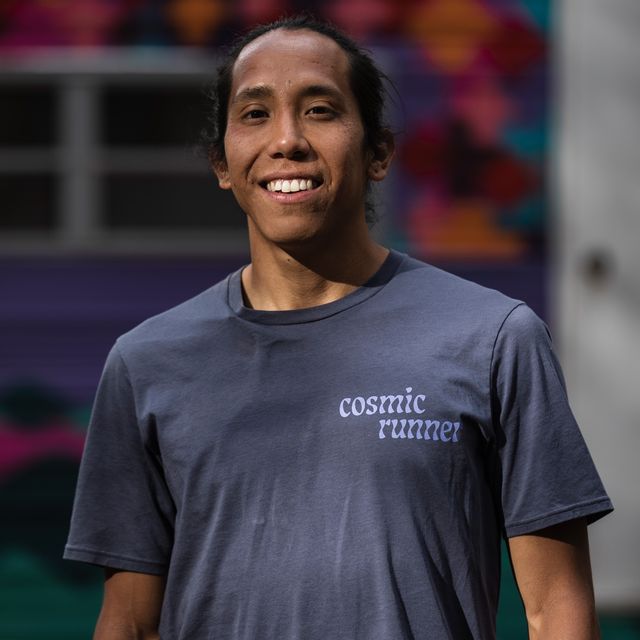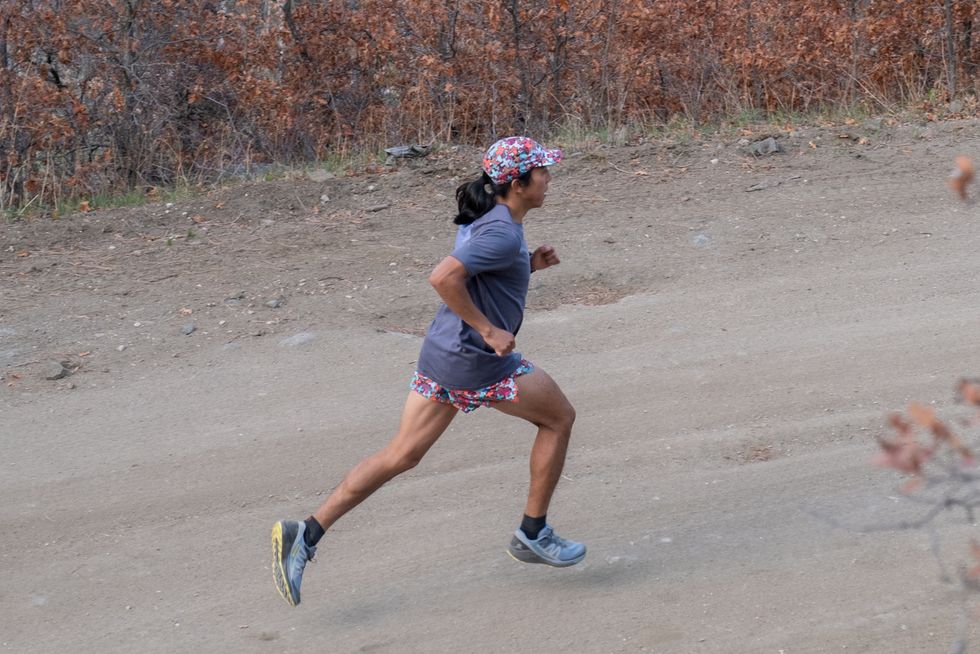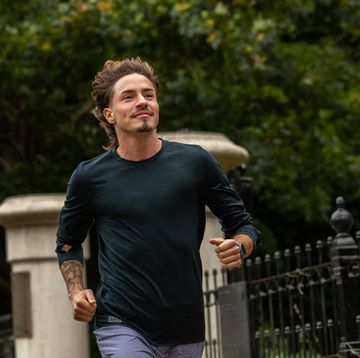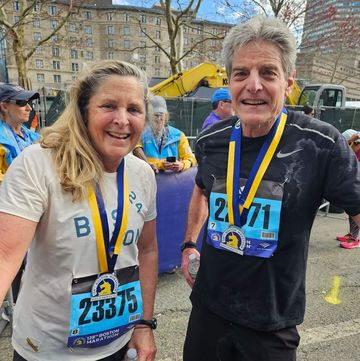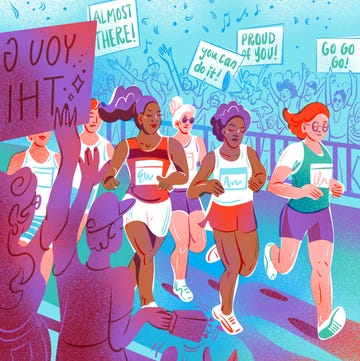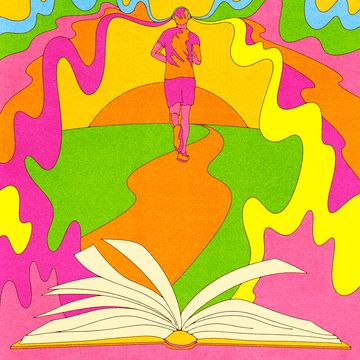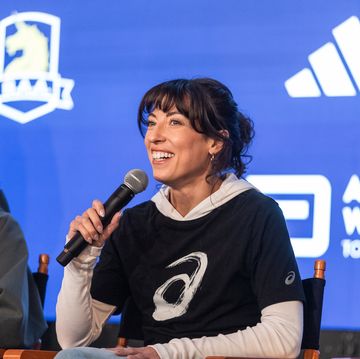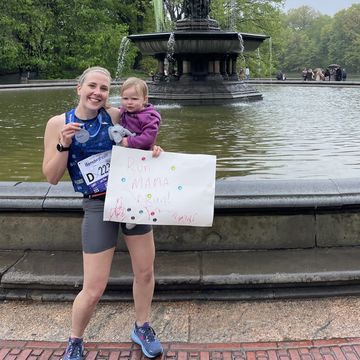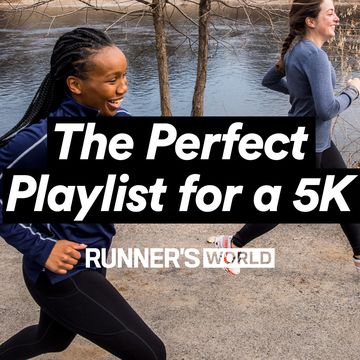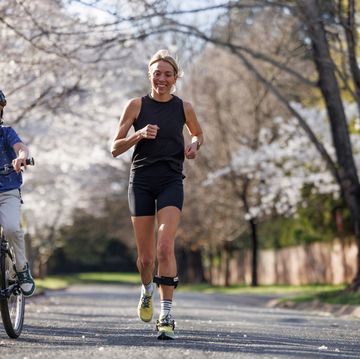For Santa Fe-based ultrarunner Christian Gering, the COVID-19 pandemic hasn’t brought much racing, but rather, more time to reflect on his relationship with running as it relates to his culture. This in turn lent itself to his participation in the design of Janji’s upcoming American Southwest Collection.
Gering, who was born in Las Vegas and grew up in New Mexico, had an early introduction to long-distance running. He completed his first marathon at age 13 at the Rock ‘n’ Roll Las Vegas Marathon with his father and brother, finishing in around 4:45.
Nothing about the race was exactly ideal; Gering experienced typical first-marathon challenges, such as overuse injuries during training and dehydration due to overly hot race conditions. However, he still vividly recalls the race experience, pushing himself out of his comfort zone as a young person who hadn’t adequately trained for the distance.
After that first marathon, Gering, now 30, moved to Santa Fe, New Mexico (Oghá P'o'oge Owingeh, which is Tewa territory), to live with his grandparents and joined his high school cross-country team. Through that, he became a disciplined and structured runner. He even ran two half marathons—one before enrolling in art school at the Institute of American Indian Arts, and another during his freshman year, both in New Mexico.
“Even from a very early age, knowing my mother was a runner in high school and college, running has always been culturally rooted for me, since movement is very important in our communities,” Gering told Runner’s World. “There wasn’t so much of an emphasis on pushing myself in a way to be a ‘distance runner’ growing up, but the importance of being outside, moving, and having a connection and relationship with the land while getting outside in any shape or form was always highlighted.”
→ For exclusive access to all of our health and fitness tips, join Runner’s World+ today!
However, Gering struggled with substance abuse and dropped out of art school. Gering says he has always been deeply rooted in his native San Felipe Pueblo culture, but he credits the year in between switching schools as a pivotal time in which he rediscovered himself and reconnected with his culture. He worked on his grandfather’s farm on the San Felipe Pueblo reservation, planting things like corn, melon, squash and chilis. Also, he grew to appreciate his relationship with running more, along with the family values that also deeply influenced it.
“This time gave me a place to reset and rejuvenate, especially after coming out of art school and having picked up some tendencies that I realized were not uplifting of my spirit and who I am,” he said. “So much of my basis of run training was based on being in the field, connecting to the land, seeds, and plants, along with the mountains and trails. So I would say that was a very beautiful time because it was spent outside, under the sun and elements, and it really formed and cemented why I wanted to continue running.”
After that semester away, Gering enrolled at Fort Lewis College in Durango, Colorado—a Native American-serving school that allows Indigenous students to have their tuition expenses waived—where he walked onto the cross-country team.
“I admittedly felt a little intimidated, as there were two Kenyan runners on the team and many of the newer runners were actually getting spotted and recruited to the team,” he said. “But from there, I only elevated myself based on discipline, hard work, and the connection to other people who wanted to see how far we could push ourselves.”
Gering went on to set multiple school records, set an 8K PR of 24:13, and qualified for nationals three times, once as a team and twice as an individual.
“My overall goal looking back was to become All-American and that just wasn’t happening, but along the way, I broke so many records and was able to leave what I feel like was the legacy of my experience from where I was coming from,” Gering said. “There was also so much beautiful training ground for people to elevate themselves in the sport of running, and that was where I finally felt supported and recognized the opportunity that was afforded to me based on my athletic capabilities in an environment where I represent the Indigenous communities.”
In the summer in between his junior and senior year of college, Gering tackled his first ultramarathon at the Ultra Ventures 50K in the North Rim of the Grand Canyon—and won the race. After graduating with his degree in environmental sciences in 2015, he participated in the Red Hot 55K, finishing fourth behind Alex Nichols, Rob Krar and Jim Walmsley. That was when he decided to pursue competitive ultra running, primarily because he saw a glaring lack of representation among Indigenous runners in that corner of the sport, which he agrees is still prevalent in ultra and trail running.
“To me, the consideration of inclusion and equitable opportunities in the sport is where there is the need for me to be present within these competitions and opportunities,” he said. “It also serves to make room because if I were the only one here, it would be exclusionary and I don't think any of us are looking for tokenism or just any type of racial showcasing.”
Gering has since gone on to compete at the international level several times, going on to nab wins at the 2015 Bandera 50K, 2018 Jemez Mountain 50-Miler, and the 2019 Javelina 100K, finishing the latter two races in course-record time. One of his most memorable racing experiences was at the 2018 Asian Skyrunning Championships, where he finished second in his first race as a Salomon-sponsored athlete.
“Being a part of Salomon-sponsored team and having these opportunities to go travel abroad to compete at an international competitive elite level as one of the only people in representing the United States from an Indigenous community, wasn’t necessarily a no-brainer,” he said. “It was more of that because I know about this information that I have the ability to use that as a platform, to be able to share it with other Native people.”
How Gering uses running to connect with his community
Gering, who also currently works as a multimedia artist in addition to running as a sponsored athlete for Salomon and Janji, found that his second act with higher education opened his eyes to the importance of having other passions and priorities in life—and that’s something he readily tells others.
“What I share with younger Indigenous people, is that we can have the passion, but we also have to find ways to make it feasible for the things that we also want to live into beyond running,” he said. “I’m proud of the fact that I was able to leverage the opportunity to get an education without accumulating any financial debt, and I want to see more Indigenous people being able to leverage opportunities like this and have access to education.”
Gering also noted that competing as a sponsored ultrarunner has allowed him to run for the betterment of himself and the health of his community. He explained that running’s historical ties to Indigenous communities can be widely understood when viewed through the lens of ultramarathon and trail running.
“It’s really a dream come true because when you look at the historical and cultural component, we [meaning Indigenous communities] have been ultrarunning all our lives because when people didn’t have planes or vehicles, they had to use their feet,” he said. “We are only practicing and continuing that tradition based upon how we’ve come to understand running, by learning from the communities that have a long-standing relationship with running.”
An improvement Gering would like to see when it comes to fostering inclusivity is reconsidering who is a part of the conversation when naming mountains and trails.
“Many current race and trail names come from romanticized versions of historical components of this country, which are actually inherently racist, derogatory, and culturally ignorant of the fact that it’s not necessarily representing the full community,” he said. “If we’re saying we’re trying to be inclusive, then we need to consider what we’re naming them because it could divert people’s interest in wanting to participate. That’s where I think it’s important for us to show up for Black, Indigenous, and people of color. If there’s a continuation on people-naming and doing things as usual, that’s not okay, because the moment that we step into these spaces, we’re going to realize we’re not as welcome as we think.”
Looking ahead
Although Gering still has competitive running ambitions, he hasn’t raced much in the last year and a half, despite the fact that ultra and trail races were some of the main running events that were spared of cancellations during the COVID-19 pandemic. Much of his hesitation was fueled by the fact that Indigenous communities have been some of the most significantly impacted by COVID-19.
He was initially planning to race the Sierre-Zinal mountain race in Switzerland this year but held off based on the current situation with the Delta variant. He is hoping to make it to the race next year to better his time from 2019.
“There were a lot of people wanting to get back to racing as soon as possible without regard to overall communal health,” he said. “With how much running is a way of connecting to our community, land, and selves, that’s where I’m at times challenged by the sense of wanting to race because of where I come from and how I practice running, and it’s not so much about just the competitive level anymore. With the pandemic limiting these opportunities, I want to evolve and change my understanding of what running is now and what it might mean for a person. I hope I can challenge others in a good way to have consideration for not only themselves, but also the people and their land that we run upon.”
Collaboration with Janji
Gering’s self-imposed break from racing has also allowed him to pursue more artistic opportunities, specifically the clothing line for Janji that he spent last fall designing for the brand’s American Southwest Collection. The line, which launches September 16, will include t-shirts, tank tops, shorts, and jackets, as well as accessories like hats and a sling bag. Gering noted that the inspiration for the clothing line stemmed from the influence of the land and his connection to running along the depicted landscapes.
“This project has allowed me to have that same competitive spirit of wanting to push myself, but in this different way to provide this gift to the community,” he said. “A lot of these cultural motifs and icons that you'll find within the designs stems from what can be translatable to a lot of communities here in the Southwest.
“At the same time, what I’m trying to share is that there’s a connection and a middle ground between land and sky. When we’re running along these landscapes, we are putting into motion and intention the greater practice of us having kinship in relation to land and sky. We’re putting our footsteps on the ground, running up trails and running pathways that lead us normally to high points. And along the way, we have guidance from [things like the trees, sun, and stars] to help guide and give us an understanding of where we are in relation to this place.”
Gering is also hoping to continue to push himself artistically and pursue other opportunities like this collaboration with Janji. Other current and upcoming running-focused projects include graphic design work for an exhibit for the High Desert Museum in Bend, Oregon, as part of a project where Indigenous runners are being interviewed about why they run and what running means to them.
“I’ve enjoyed being able to be sponsored, travel, and receive gear and running shoes as a professional runner, but as far as the long-term picture, I would like to provide these gifts and artistic creative expression to the industry,” he said. “I’d like to be able to have more of a path, whether it’s for apparel or footwear, since there's a certain point that you have to start considering what's happening after your professional running career.”
Gering hopes to also inspire all runners to examine their relationship with the running spaces they gravitate to in their communities.
“I invite people to go look for other places to run around their community and not even the most well-known or scenic ones,” he said. “When you take the chance to run around where we live and then build community, you start to see a different understanding of what your community might be made of or made up of what’s happening. Once you can start to see the different components of how lands are treated, respected, or lived upon, you can start to understand the impact you’re having on the land by living in that place. So I highly encourage people to go take that back road that might just be a flat back road or less traveled trail to hopefully deepen their understanding of their relationship to the land.”
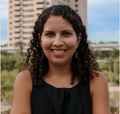
Emilia Benton is a Houston-based freelance writer and editor. In addition to Runner's World, she has contributed health, fitness and wellness content to Women's Health, SELF, Prevention, Healthline, and the Houston Chronicle, among other publications. She is also an 11-time marathoner, a USATF Level 1-certified running coach, and an avid traveler.
